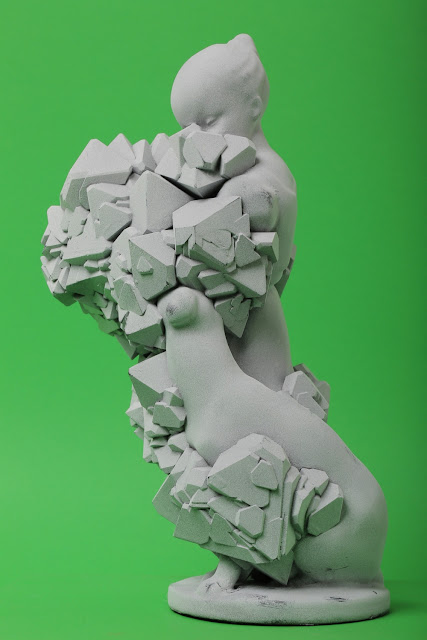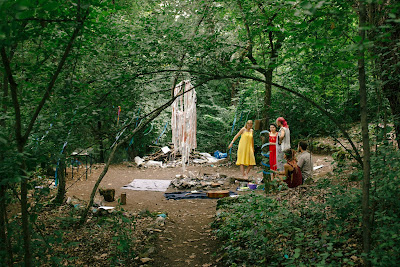Entropy. The Art of Disintegration: Polish-Hungarian group exhibition (April 2018)
13- 27.04.2018,
Wrocław
Curators: Patrycja Rup
(PL), Tomasz Piars (PL/HU)
Artists: Anna Kolodziejczyk (PL), Kamil Moskowczenko(PL), Paweł Baśnik (PL), Łukasz Huculak (PL), Dy Tagowska (PL), Tomasz Piars (PL), Dániel Bajkó (HU), Ákos Bánki (HU), Péter Szalay (HU), Géza Szöllősi (HU)
Organizer:LATARKA Gallery from Budapest.
Partners: Fundacja Art Transparent, mia ART GALLERY, Akademia Sztuk Pięknych im. Eugeniusza Gepperta we Wrocławiu
"The future is but the obsolete in reverse."
Vladimir Nabokov
“Like energy, entropy is in the first instance a measure of something that happens when one state is transformed into another”
P.W. Bridgman
Artists: Anna Kolodziejczyk (PL), Kamil Moskowczenko(PL), Paweł Baśnik (PL), Łukasz Huculak (PL), Dy Tagowska (PL), Tomasz Piars (PL), Dániel Bajkó (HU), Ákos Bánki (HU), Péter Szalay (HU), Géza Szöllősi (HU)
Organizer:LATARKA Gallery from Budapest.
Partners: Fundacja Art Transparent, mia ART GALLERY, Akademia Sztuk Pięknych im. Eugeniusza Gepperta we Wrocławiu
"The future is but the obsolete in reverse."
Vladimir Nabokov
“Like energy, entropy is in the first instance a measure of something that happens when one state is transformed into another”
P.W. Bridgman
The universe isaiming for more and more entropy. Stars are getting colder, galaxies are moving away and if you believe astrophysicists, everything will get darker, heat will be evenly distributed throughout the universe. Entropy as another coalition of science and art. Scientific term ‘entropy’ gained the popularity in the field of culture and art in the 1960s, mainly thanks to artists and new perspective for art that celebrates disintegration, disassembly, decomposes critics gathered around the New York “Park Place Group”.
Entropy has become a new perspective for art that celebrates disintegration, disassembly, decomposes time, matter and space to look at isolated factors. In social systems, a state of low entropy and a high degree of internal organization corresponds entropy seems to be a positive process, creating space for the freedom of to state, caste and monarchist or dictatorial regimes of power. The increase of individuals.
Can entropy as a concept taken from physics reflect the processes occurring in contemporary culture and art? Contemporary culture loses its rank and strength of connotations. Donald Kuspit acknowledges the concept of entropy as crucial for persuasion. Entropy in the field of art remains a term with pejorative "The End of Art" takes the reader through a path that in his opinion understanding contemporary art. The American critic in his popular book between reason and senses for Kuspit, and consequently leading to the led art to its transformation into its own negation. Entropy means a split brings to mind the collapse of culture, but here the key question is whether we disintegration of art. The disintegration of aesthetic and cognitive values, underpin a new type of culture.
Full version:
Entropy, the art
of disintegration / Entropia, sztuka rozpadu
"The
future is but the obsolete in reverse."
Vladimir
Nabokov
Like energy,
entropy is in the first instance a measure of something that happens when one
state is transformed into another
P.W. Bridgman
Scientific
term ‘entropy’ gained the popularity in the field of culture and art in the
1960s, mainly thanks to artists and critics gathered around the New York “Park
Place Group”. One of them was Robert Smithson, who played a key role in this
process by writing and publishing his essay "Entropy And The New
Monuments" in 1966. The artist saw in entropy a metaphor of the processes
taking place in contemporary American culture. Entropy has become a new
perspective for art that celebrates disintegration, disassembly, decomposes
time, matter and space to look at isolated factors. It inspired numerous art
works in the field of minimalism, conceptual art, process art and performance,
it became the theoretical basis for the land art, of which Smithson was the
leading representative.
Entropy as
another coalition of science and art. One of the essential quantities used in
thermodynamics. It determines the degree of disorder of the system, in other
words the degree of its uniqueness, it is a measure of the number of
microstates giving a certain state. While ordered systems can be implemented in
a few ways, they are characterized by small entropy, while disordered systems
can be implemented in many ways, so they have large entropy. Systems with the
largest chaos (least ordered) are most probable. According to the second law of
thermodynamics, in nature entropy can only increase. On the other hand, if it
decreases locally, then at the same time it must increase somewhere else, so if
we start to organize something in some area of space, the result will be an
increase in entropy in another. The universe is aiming for more and more
entropy. Stars are getting colder, galaxies are moving away and if you believe
astrophysicists, everything will get darker, heat will be evenly distributed
throughout the universe.
Entropy does
not have to lead to chaos. Low entropy can create conditions for the existence
of a crystal, here the concept of a perfect crystal appears, due to the third
law of thermodynamics, which was introduced by Walther Hermann Nernst. Entropy
in information theory is a quantity that specifies the number of bits of
information contained in a given message or source. The bit is therefore a
measure of uncertainty. While this is the presentation of entropy in the
strictly scientific theory, let's look at one more extended definition, which
is proposed by Tate Modern, focused on social aspects: “Entropy is the
inevitable and steady deterioration of a system or society”. In social systems,
a state of low entropy and a high degree of internal organization corresponds
to state, caste and monarchist or dictatorial regimes of power. Such systems
require a strong concentration of power in the hands of individuals or a small
group centrally managing society and having strong control and coercion bodies.
However, even here the hardest crystals can be crushed. The increase of entropy
seems to be a positive process, creating space for the freedom of individuals.
Can the increase of entropy in social systems bring real threats? What are the
correlations in social systems guaranteeing their stability and resistance to
disorders? How would the optimal scheme look like? These questions are still
waiting for answers. However, entropy here is a reversible process, it raises
many doubts as a metaphor of social systems.
Entropy in
the field of art remains a term with pejorative connotations. Donald Kuspit
acknowledges the concept of entropy as crucial for understanding contemporary
art. The American critic in his well-known book "The End of Art"
takes the reader through a path that in his opinion led art to its
transformation into its own negation. Criticism is especially directed at
Duchamp and Newman, whom he blames for the destructive impact on aesthetics. A
work of art loses its aesthetic value. Entropy means a split between reason and
senses for Kuspit, and consequently leading to the disintegration of art.
Further problems come with the institutionalization and commercialization of
art. Can entropy as a concept taken from physics reflect the processes
occurring in contemporary culture and art? Contemporary culture loses its rank
and strength of persuasion. Entropy, caused by the degradation of "high
art" and the disintegration of aesthetic and cognitive values, brings to
mind the collapse of culture, but here the key question is whether we are
dealing with a fall or reformulation, with changes in the scheme that would
underpin a new type of culture. Kuspit, sharply criticizing contemporary
culture and art, many times aims at its banality and simplicity. Meanwhile, its
components are much more complex than one might think after a superficial
analysis. Multi-context structures created on the basis of fragments of images
and cultural texts replicate and combine to create new, more complex forms.
However, the pace of constant consumption of images and meanings affects the
image of the world, which seems to be made of fragments and debris, difficult
to perceive. These processes are supported by the technological development and
a wide range of media, but also the group of creators has been expanded, this
time with intelligent machines.
Press info:
http://arttransparent.org/event/entropia-sztuka-rozpadu/
https://www.facebook.com/events/mia-art-gallery/entropy-art-of-disintegration-entropia-sztuka-rozpadu/1654621667936274/
https://www.asp.wroc.pl/?module=News&controller=Read&action=news&id=11752
http://cojestgrane24.wyborcza.pl/cjg24/Wroclaw/1,43,560303,Entropy--art-of-disintegration---Entropia--sztuka-.html

















